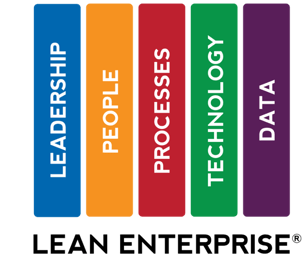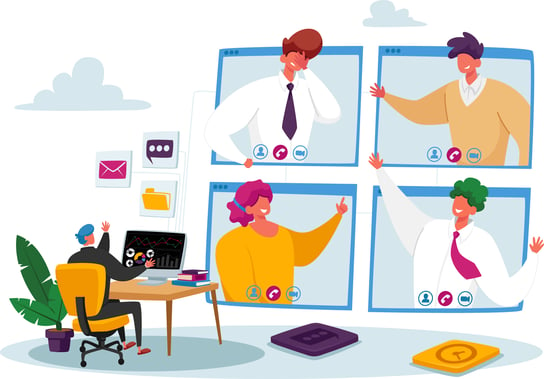Organizational Effectiveness
Organizational Effectiveness measures how well a business uses its resources to meet its goals and realize its strategy. Efficiency is a significant component of Organizational Effectiveness, but only where that efficiency can be shown to move the strategy forward. Sometimes businesses focus on efficiency in a vacuum without clearly demonstrating how it fulfills the organization's higher-level goals. Organizational Effectiveness is essential for companies because it focuses on the utilization of its people and resources and measures its impact on the long-term sustainability and profitability of the company. There are many great resources on how Organizational Effectiveness can improve productivity, drive efficiency, and enhance profitability. We encourage you to take a look at some of those resources. Our focus for the rest of this post will be on the people side of things.
Team D3 Consulting
 Team D3 approaches Organizational Effectiveness through the Five Pillars of our Lean Enterprise approach. While all five pillars are important, some of the most significant opportunities are found in the People pillar. Companies don't exist without them. Aligning the people within the organization to the mission, values, strategies, and goals is critical to realizing Organizational Effectiveness. This article might speak more to business leaders and managers, but if you aren't in that position (yet), please keep reading. At the very least, we hope to introduce some ideas you can share with others in your company to start making a difference wherever you are.
Team D3 approaches Organizational Effectiveness through the Five Pillars of our Lean Enterprise approach. While all five pillars are important, some of the most significant opportunities are found in the People pillar. Companies don't exist without them. Aligning the people within the organization to the mission, values, strategies, and goals is critical to realizing Organizational Effectiveness. This article might speak more to business leaders and managers, but if you aren't in that position (yet), please keep reading. At the very least, we hope to introduce some ideas you can share with others in your company to start making a difference wherever you are.
Factors, Opportunities, and Challenges for Organizational Effectiveness
Clear Goals
Meaningful goals start with a clear vision of where the company is going in the short and long term. To be an effective business, you have to be able to keep both in sight and give each the attention it deserves. As a leader or manager, or just someone in charge of a particular project, engaging with all levels of the organization in the goals-setting activities wherever possible is vital. It is also an excellent way to ensure that the goals are relevant to all groups and that they understand how their work will connect to the broader organizational outcomes.
Goals should be measurable and as transparent as possible. A quantitative metric is not the only option; sometimes, better options exist. Qualitative and subjective measures are also necessary, especially when dealing with our employees' and customers' changing perceptions and opinions. Make sure your goal and choice of measurement are a good fit. A percentage of attainment metric is good if you are tracking revenue growth. But if you are trying to assess employee engagement, reporting the number of emails they send will take much work. Instead, think about something like structure manager interviews. Measuring employee perceptions alongside other core business metrics brings valuable people resources into a better alignment. Keep in mind that goals are the primary focus of assessing Organizational Effectiveness. Achieving your goals is excellent, but the actual value is helping the whole organization achieve them. Without goals, how can you know if you are achieving the most important results?
Communication and Collaboration
The most crucial aspect of effective goal setting and execution is the ability of leadership to communicate it to their managers and employees. If goals are unclear, or the actions that will support them are vaguely defined, it will be much more difficult to reach them effectively. If people don't know or don't understand the goals or how they move the company strategy forward, it will be challenging to keep them all moving in the right direction. With a shared understanding facilitated by effective communication, teams can begin collaborating toward that common goal rather than in silos or going in opposite directions. Clear communication allows diverse groups to maintain alignment and increase collaboration across teams and functions. The employees closest to the process should participate in streamlining the work, and management should help them maintain alignment with the goals and strategies. Our proven communication planning resources can be used to create consistency and effectiveness in strategic communication. It isn't something that can be improved overnight, but with guidance and commitment, it will pay dividends in the long-term effectiveness of your organization.

Leadership and Management
Leaders set the stage for the organization because they set the strategy. It is that strategy that Organizational Effectiveness seeks to fulfill. Leadership is responsible for making the direction clear for their employees. Leaders and managers are responsible for ensuring that teams have the resources they need and clearing their team's roadblocks to success. Management has the unique position of being a filter and focusing group responsible for connecting the leadership's strategy to work being done across the company and at all levels. The more complex the organizational structure, the more critical the manager's role in connecting their teams to the organization's strategy.
We've worked with great leaders that exude passion and vision. One, in particular, was beginning to reach a critical mass of effectiveness. They knew where they wanted to go. They were experts in doing the work that has positioned them exceptionally well in their industry. Scaling that effort to increase their effectiveness alongside their growth was a challenge. Fast-growing companies can often outgrow their org chart, which impacts how they communicate, delegate, and collaborate on a new scale of opportunities. This group was at a crossroads. At some point, leaders must decide whether they are ready to right-size their company for effectiveness to continue their growth trajectory. Or, equally valid if it is time to scale back and find the pace and volume that matches the skills and bandwidth of their personnel.
Sadly, even the most well-intentioned leaders and managers can get into trouble. When pressure mounts and resources become increasingly constrained, these individuals can effectively act to right the ship. A lack of alignment across this group is one of the most costly challenges facing businesses and the most difficult to address. As mentioned above, we know that leaders and managers are people, too. We don't pretend to know the ins and outs of your business, but we do have a common baseline of best practices to align leadership and management behaviors toward your shared goals.
Employee Engagement and Retention
When employees feel connected to the leadership team and the company strategy, they gain a sense of ownership of the results. Most employees want to do good work and improve the outcomes not only for the company but also for themselves. When people feel a sense of ownership, they are also more likely to weather the challenging times and to lean on each other for support. If they believe the whole team is going in the same direction and behind them, fear and uncertainty are reduced. This makes a significant impact on a company's ability to retain quality people.
Sports teams often serve as a relatable storyline for how to run effective or ineffective organizations. Over the last 25 years, basketball's San Antonio Spurs are one example that stands out. Over the last couple of decades, this organization has represented utter stability regarding ownership, management, coaching, and standard operating procedures. The system was to stress a "team before me" approach, to share the ball and the glory. At the end of the 90s and well into the 2000s, the team boasted of many championships and near misses. The culture they instituted contrasted starkly with the glitz and glamour of many of their competitors. However, despite their emphasis on the team, they also had Hall of Fame talent. As those all-time careers have closed in the last decade, the organization is searching for the results they enjoyed in previous years. As with many organizations looking to maintain a high level of excellence in culture and overall effectiveness, they must recognize the importance of great talent to execute within a strong, established culture. Conversely, an attractive system (or culture) can help recruit the next wave of exceptional talent. Both are critical for long-term effectiveness.
Regardless of your system or what kind of talent you have on your team, one thing is sure. Change is tough. And the stress of poor performance only adds to the challenges. There is an unavoidably individual experience to change that, if not managed well, can lead to limited success in improvement initiatives. It is not all doom and gloom, however. Some research-based methods have been shown to improve the successful adoption of changes on the people level. It is not about following a script or checking boxes in a master change plan. It takes a careful and tailored approach to each company's culture and people to help the process succeed.
Continuous Improvement Culture
Culture is critical to all organizations, but even more so for those that rely heavily on knowledge work and solving complex problems. Employees need to feel empowered to take risks and push boundaries in the pursuit of continuous improvement. Without that, innovation has to come from management and leadership, and the talents and experiences of the broader employee base are lost. When employees at all levels understand the strategy and can see how their work drives it forward, they are more likely to experiment in ways that reflect that. Improvement takes innovation, innovation takes risk, and risk needs to be acceptable within the organization.

Trust resides at the core of this acceptance and creates a foundation for a culture with a spirit and practice of continuous improvement. A culture is only as strong as its determination to keep the rules and clearly identify what is tolerated and what is not. This level of commitment and openness to accountability carves out some space to innovate, to take risks, and to make the mistakes that will inform us to create something better the next time. An organization with this kind of transparency is powerful, and efficiency can be fine-tuned with the proper channels of communication that reinforce binding commitments and high-level follow-through.
Our Approach to Supporting Organizational Effectiveness
How We Support and Enhance Organizational Effectiveness
Team D3 has many consulting teams that can impact a broad range of Organizational Effectiveness areas. Our business consulting team supports our core consulting team, but we pay a special focus on the people aspects of Organizational Effectiveness. We strive to support the precise definition and communication of organizational goals and strategies. We also facilitate a clear understanding of the work processes as executed by the employees on the front line. We then use that understanding to help those frontline employees see how potential improvements will impact them and their work. As we stated above, leaders and managers are people, too. Managers, in particular, are tasked with the dual role of managing others while also being managed by the leaders above them. This is a difficult position, and we help the organization understand the best ways to leverage this critical group. Our approach is aligned with traditional continuous improvement mindsets but mostly focuses on creating the cultural elements that underpin technical improvement opportunities.
When we focus on the people in an organization, we do not see them as cogs in a machine. We see them as unique individuals with something to bring to the table. Each has experience, ideas, and values that can move the company forward. Improvement is possible with the right coaching, structure, and guidance. Even if past efforts have been a struggle. We use a blend of methodologies designed to drive business results by connecting strategy, organizational design, and human capital management. Organizational size is an important factor. Within large organizations, we have found it essential to expand activities from the individual to the team level without losing sight of individual impacts.
We try to adhere to and model the Lean mindset of respect for people. This respect for people and desire to improve without playing the blame game is the starting point for many of the interventions we bring. We are systems thinkers who focus on solving wicked problems. Not every challenge can be addressed with a quick fix, and sometimes the only thing we can do is adopt a deliberate experimental mindset to improve. That's the key to wicked problems; they don't have a "right" solution. They are highly contextual and full of interrelated constraints and opportunities. By taking a systematic view across the organization, we can highlight these relationships and help our clients keep an eye on the big picture amid the chaos.
Our Approach to Supporting Organizational Effectiveness
Foundational to our approach are the Five Pillars: Leadership, People, Process, Technology, and Data. Our business consulting team focuses heavily on the people pillar. We are fortunate to partner with our broad base of experts who can help across each of the other pillars. We are Continuous Improvement minded, knowing that the pursuit of perfection is the key, not perfection itself. There is no perfect state in our constantly evolving business environments. We draw from Organizational Psychology, Lean, Agile, Design Thinking, and Human Centered Design. Each has something to offer, and even more importantly, they provide multiple perspectives to work with our clients to find the best approach for them. We value the uniqueness of each client and put their needs and context at the forefront.
How We Are Different
We focus on educating ourselves in testing and retesting a diverse range of business ideologies and methodologies. We don't come with a solution to a narrow set of problems. We come with an open mind, a desire to learn and understand, and ultimately to help you make the improvements you believe are best in your business. We will bring our experience and expertise to the engagement, but our goal is to empower the leaders, managers, and employees to own and carry on the solutions we implement together.
If you're interested in exploring this journey, reach out for a chat by using the form below!
To comment on this blog post please use the comment form below.






